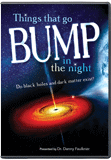
Finding “The Missing Cornerstone of Physics”
Physicists applaud around the world as CERN scientists announce finding “the missing cornerstone of physics.”
News Source
“We have now found the missing cornerstone of particle physics,” announced Rolf Heuer, director of the European Center for Nuclear Research (CERN) on July 4. “We have a discovery. We have observed a new particle that is consistent with a Higgs boson.” Thundering applause resounded from the packed auditorium in Geneva and at the 36th International Conference on High Energy Physics in Melbourne, Australia, which was linked by a live feed.1 Joe Incandela and Fabiola Gianotti, the heads of the two large teams of scientists at CERN, announced they have detected a new subatomic particle consistent with the elusive Higgs boson, commonly called the “god particle.”
The Standard Model of physics is the currently most-accepted model to explain how the physical universe works. Within the Standard Model, which involves quantum physics, some high-energy particles—like electrons and quarks, the tiny particles comprising protons and neutrons—have rest-mass, and other particles—photons, essentially particles of light energy—have no rest-mass. But the Standard Model has not found the reason some particles have rest-mass and others do not. Theoretically, the universe is filled with a Higgs field mediated by Higgs bosons that impart rest-mass to particles of matter as they interact with it.2 The Higgs boson thus is the theoretical—and now likely observed—subatomic particle that imparts rest-mass to matter.
Mass is a measure of how much matter something contains. Gravity acts on mass to give things weight and ultimately to hold the physical universe together.
Such a subatomic particle is extremely unstable. Therefore, in an effort to find proof of the existence of the elusive particle and then to study its characteristics, physicists have for several years been colliding beams of high-energy protons in the 17-mile long Large Hadron Collider under the Alps. They study the debris resulting from the collisions in search of subatomic particles. Now that a subatomic particle closely fitting the expected characteristics of the predicted Higgs boson has been repeatedly found by the two teams, they believe they’ve found it. Read more about the physics involved and the significance of the findings at “Beams Collide Today in Expensive Hadron Collider.”
Over the past months there have been rumors and hints that this discovery was imminent. In particle physics, for a discovery to be deemed truly “discovered,” it must be detected repeatedly such that there is only the remotest possibility that the signals detected could have resulted from random chance. This is called a “five –sigma” level of certainty, and that is the benchmark that has finally been reached. 3
Notably, as further testing examines the nature of this subatomic particle, physicists hope to learn more about the way the universe works.
Notably, as further testing examines the nature of this subatomic particle, physicists hope to learn more about the way the universe works. As with the results thus far, repeatable observations are made and the data interpreted and compared with hypotheses and predictions. This is an excellent example of how experimental science works and how science can help us understand the way God upholds His creation.
What these results do not (and will not) reveal, as many media pundits suggest, is how the universe originated. British scientist Peter Higgs—who was on hand in Geneva for the announcement4—postulated the existence of the Higgs field that produces the Higgs boson “as the way that matter obtained mass after the universe was created in the Big Bang.5 As one of the CERN researchers added, “Without it, or something like it, particles would just have remained whizzing around the universe at the speed of light.”6
Although many believe the collision of the proton beams in the LHC re-creates the conditions immediately after the big bang and therefore claim the Higgs discovery will unlock the secret of how the universe blew into existence without God, it does no such thing. The ability to create a situation in a present-day well-designed and enormously expensive laboratory does not prove the situation ever came about naturally in the past or that such an event produced the universe in which we live. A discovery that deepens our understanding of the nature of matter and energy does not rule out a supernaturally created origin for that matter and energy.
“Thanks, nature!” Gianotti said to laughter, alluding to the unpopular layman’s term for the Higgs boson, the “god particle.” The term was coined by physicist Leon Lederman, much to the consternation of Higgs and many in the Higgs-hunting business,7 due to his book title, The God Particle: If the Universe is the Answer, What is the Question? But though the Higgs boson can help us better understand the way the physical universe works and fill in the gaps in the Standard Model of physics, it does not explain how the universe could come into existence without allowing “a divine foot in the door.”8
Further Reading
- Beams Collide Today in Expensive Hadron Collider
- News to Note, December 24, 2011
- The Elusive God-Particle Teases Physicists But Tantalizes Theistic Evolutionists
- Does the Big Bang Fit with the Bible?
- A Miniature Big Bang or More Hot Air?
- Big Bang Blow Up
- In Search of God
For More Information: Get Answers
Remember, if you see a news story that might merit some attention, let us know about it! (Note: if the story originates from the Associated Press, FOX News, MSNBC, the New York Times, or another major national media outlet, we will most likely have already heard about it.) And thanks to all of our readers who have submitted great news tips to us. If you didn’t catch all the latest News to Know, why not take a look to see what you’ve missed?
(Please note that links will take you directly to the source. Answers in Genesis is not responsible for content on the websites to which we refer. For more information, please see our Privacy Policy.)
Footnotes
- www.cosmosmagazine.com/news/5763/cern-“we-have-a-discovery”
- P. Spotts, “Will Scientists Announce Discovery of Higgs Boson? Buzz Is Building,” The Christian Science Monitor, July 2, 2012, http://www.csmonitor.com/Science/2012/0702/Will-scientists-announce-discovery-of-Higgs-boson-Buzz-is-building.-video.
- L. Davies, “Higgs Boson Announcement: Cern Scientists Discover Subatomic Particle,” The Guardian, May 21, 2014, http://www.theguardian.com/science/blog/2012/jul/04/higgs-boson-discovered-live-coverage-cern.
- Ibid.
- R. Evans, “The Higgs Boson: What Has God Got To Do With It?,” Reuters, December 14, 2011, http://www.reuters.com/article/2011/12/13/us-science-higgs-god-idUSTRE7BC28H20111213.
- Ibid.
- News to Note, December 24, 2011
- From a book review by Harvard evolutionist Richard Lewontin: Richard Lewontin, “Billions and billions of demons” (review of The Demon-Haunted World: Science as a Candle in the Dark by Carl Sagan, 1997), The New York Review, p. 31, 9 January 1997.
Recommended Resources

Answers in Genesis is an apologetics ministry, dedicated to helping Christians defend their faith and proclaim the good news of Jesus Christ.
- Customer Service 800.778.3390
- © 2024 Answers in Genesis







